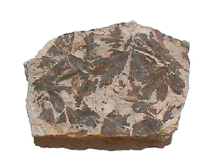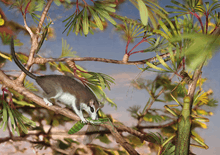Ginkgoales
Ginkgoales is a gymnosperm order containing only one extant species: Ginkgo biloba, the ginkgo tree.[1] It is monotypic, (the only taxon) within the class Ginkgoopsida, which itself is monotypic within the division Ginkgophyta. The order includes five families,[2] of which only Ginkgoaceae remains extant.[3]
| Ginkgoales | |
|---|---|
 | |
| Jurassic Ginkgo leaves | |
| Scientific classification | |
| Kingdom: | Plantae |
| Clade: | Tracheophytes |
| Division: | Ginkgophyta |
| Class: | Ginkgoopsida |
| Order: | Ginkgoales |
| Families | |
| |
History
The first Ginkgo leaves were found from the Triassic period, but there were many species of Ginkgo during the Jurassic and Cretaceous periods as well. These periods, known collectively as the Mesozoic era, were when diversity and distribution for all plants were at their highest, including in Ginkophytes.[4] It was in the early Cenozoic period that Ginkgophytes nearly became extinct, specifically during the early Cretaceous and Tertiary periods.[2][4] The only remaining Ginkgophyte was Ginkgo adiantoides – a polymorphic species.[5] Modern Ginkgo trees are native to China.[2]
Reproduction
Ginkgo trees produce ovulate, pollen-bearing structures. These structures are dioecious, in that male and female structures come from different Ginkgo plants.[2] The pollen organs are very similar to angiospermous catkins. They come from the axils of the bud scales, and the leaves from the Ginkgo tree spur shoots. Pollen is contained in sacs of two to four at the tips of sporophylls on the strobiloid. Ovules of Ginkgo trees come from stalks from leaf axils on the short shoots, each containing two ovules. The ovule is fertilized by the flagellated male gametes, which can move about freely. This fertilization process begins on the tree itself in the spring. The swollen fruit-like ovules, about 2–3 cm in diameter, fall from the tree in the fall, and fertilization continues into the winter/spring.[4][5] This fruit contains a single large seed, similar to that of a cycad.[4]
Morphology
Ginkgophyte wood
Fossils that appear Ginkgo-like are filed under a morphogenus called Ginkgoxylon, Ginkgomyeloxylon, or Protoginkgoxylon. Fossilized ginkgophyte wood is not commonly found in the record, possibly because it degrades easily, and possibly because it is difficult to tell apart from the much more pervasive conifer samples.[4] Like conifer wood, it has secondary thin-walled xylem and a primary vascular system composed of eustele and bifacial vascular cambium. The tracheids in the secondary xylem rays have pitting that occurs only on the walls and is circularly bordered.[2]

Ginkgophyte foliage
Ginkgophyte foliage has stayed largely consistent since the Mesozoic. Its historically wide territory makes it an important leaf morphology, and its unique stomata and isotopic profile give it a key role in recreations of the Mesozoic and Cenozoic. Leaf fossils that resemble the Ginkgophytes are known as Ginkgoites. There are similar, now extinct, morphogens, such as Sphenobaiera, which describes fan-shaped, deeply divided leaves without clear petioles.
The distinctive shape of the modern Ginkgo biloba gives the impression of a very narrow leaf morphology, but the group is varied and diverse. The genus Ginkgo by itself contains a range of morphologies. Ginkgo digitata, from the Jurassic, has long, wedge-shaped laminae with the intercostal regions covered in stomata and resin bodies, while G. pluripartita has at most 2 cm-long leaves and is intercostally hypostomatic.[4]
Fossil gallery
 A 6.7 cm tall Ginkgo biloba leaf, with insect herbivory. Klondike Mountain Formation, Republic, Ferry County, Washington, USA, Eocene, Ypresian, 49 million years old
A 6.7 cm tall Ginkgo biloba leaf, with insect herbivory. Klondike Mountain Formation, Republic, Ferry County, Washington, USA, Eocene, Ypresian, 49 million years old A 70 mm-wide Ginkgo biloba leaf. Klondike Mountain Formation, Republic, Ferry County, Washington, USA, Eocene, Ypresian, 49 million years old
A 70 mm-wide Ginkgo biloba leaf. Klondike Mountain Formation, Republic, Ferry County, Washington, USA, Eocene, Ypresian, 49 million years old Ginkgo biloba Eocene fossil leaf from the Tranquille Shale of MacAbee, British Columbia, Canada
Ginkgo biloba Eocene fossil leaf from the Tranquille Shale of MacAbee, British Columbia, Canada Fossil of Ginkgo huttoni. Photo taken at Naturalis Museum in Leiden, The Netherlands.
Fossil of Ginkgo huttoni. Photo taken at Naturalis Museum in Leiden, The Netherlands. Fossil of Ginkgoites huttoni
Fossil of Ginkgoites huttoni
References
- Christenhusz, M. J. M., J. L. Reveal, A. Farjon, M. F. Gardner, R. R. Mill, and M. W. Chase (2011). A new classification and linear sequence of extant gymnosperms. Phytotaxa 19:55–70. http://www.mapress.com/phytotaxa/content/2011/f/pt00019p070.pdf
- Beck, Charles (2014). "Ginkgoales". Access Science. Retrieved April 13, 2017.
- "Ginkgoaceae in Flora of China @ efloras.org". www.efloras.org. Retrieved 2017-04-12.
- Taylor, Thomas N.; Taylor, Edith L.; Krings, Michael (2008-12-29). Paleobotany, Second Edition: The Biology and Evolution of Fossil Plants (2nd ed.). Academic Press. ISBN 9780123739728.
- Jalalpour, Julie; Malkin, Matt; Poon, Peter; Rehrmann, Liz; Yu, Jerry (1997). "Introduction to the Ginkgoales". www.ucmp.berkeley.edu. Retrieved 2017-04-20.